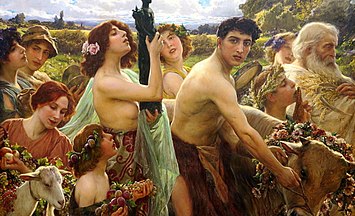Ceres


In Roman religion and myth, Ceres (Latin: Cerēs) is the goddess of agriculture, especially the growing of grains and cereals, fertility and motherly relationships. The Roman equivalent of Demeter. Ceres was an important deity of the Plebeian or Aventine Triad. She was the mother of Proserpine. Her daughter was married to Pluto, the god of the underworld. At Roman weddings, a boy carried the torch of Ceres to light the way to happiness of the couple. The dwarf planet Ceres is named after her.
Ceres found out the spelt wheat (Latin far), the yoking of oxen and ploughing, the sowing, protection and the young seed, the gift of agriculture to human beings. Before this, man were going here and there without houses or rules. She had the power to fertilize, multiply and make plants bear fruit and animals produce seed. Her rules protected all the activities of the agricultural cycle. In January, Ceres (alongside the earth-goddess Tellus) was offered spelt wheat and a pregnant sow. It was done at the movable Feriae Sementivae. This was almost done before the annual sowing of grain. The divine part of sacrifice was the entrails (exta) put in a clay pot (olla). In villages, Cato the Elder describes the offer to Ceres of a porca praecidanea (a pig, offered before harvesting). Before the harvest, she was offered some grains (praemetium). Ovid tells that Ceres "is content with little, provided that her offerings are casta" (pure).[1][2][3][4]
Ceres' main festival is Cerealia. It was celebrated from middle to late April. It was organised by her plebeian aediles. It included circus games (ludi circenses). It opened with a horse-race in the Circus Maximus. Its starting point was below and opposite to her Aventine Temple. Its turning post was at the far end of the Circus. It was holy to Consus, a god of grain-storage. After the race, foxes were released into the Circus. Their tails were burned with torches. It was done to clean the growing crop plants and protect them from disease. It is also to add warmness and strength to their growth.[5][6]
Rules
[change | change source]Ceres protected plebeian laws, rights and rules. Her Aventine Temple was the plebeian worship place, law place, treasure place and also law-court. Its foundation was almost at the same time with the passage of the Lex Sacrata. During that time, Lex Sacrata made the office and representatives of the Roman people. Tribunes were legally unable to do anything to capture or threaten the lives and wealth of those who broke the rules of Ceres.[7]
Related pages
[change | change source]- Demeter - Greek mythology version of Ceres
References
[change | change source]- ↑ John Scheid, in Rüpke, Jörg (Editor), A Companion to Roman Religion, Wiley-Blackwell, 2007, p 264; and Varro, Lingua Latina, 5.98.
- ↑ Spaeth, 1996, p. 35: "The pregnant victim is a common offering to female fertility divinities and was apparently intended, on the principle of sympathetic magic, to fertilise and multiply the seeds committed to the earth." See also Cato the Elder, On Agriculture, 134, for the porca praecidanea.
- ↑ Spaeth, 1996, pp. 35–39: the offer of praemetium to Ceres is thought to have been an ancient Italic practice. In Festus, "Praemetium [is] that which was measured out beforehand for the sake of [the goddess] tasting it beforehand".
- ↑ Linderski, J., in Wolfgang Haase, Hildegard Temporini (eds), Aufstieg und Niedergang der römischen Welt, Volume 16, Part 3, de Gruyter, 1986, p. 1947, citing Ovid, Fasti, 4.411 - 416.
- ↑ Wiseman, 1995, p. 137.
- ↑ A plebeian aedile, C. Memmius. Spaeth, 1996, p. 88.
- ↑ For discussion of the duties, legal status and immunities of plebeian tribunes and aediles, see Andrew Lintott, Violence in Republican Rome, Oxford University Press, 1999,pp. 92–101
